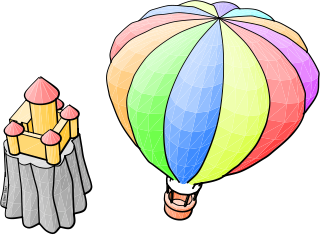
A graphical user interface, or GUI, is a form of user interface that allows users to interact with electronic devices through graphical icons and visual indicators such as secondary notation. In many applications, GUIs are used instead of text-based UIs, which are based on typed command labels or text navigation. GUIs were introduced in reaction to the perceived steep learning curve of command-line interfaces (CLIs), which require commands to be typed on a computer keyboard.

Smalltalk is a purely object oriented programming language (OOP) that was originally created in the 1970s for educational use, specifically for constructionist learning, but later found use in business. It was created at Xerox PARC by Learning Research Group (LRG) scientists, including Alan Kay, Dan Ingalls, Adele Goldberg, Ted Kaehler, Diana Merry, and Scott Wallace.

Squeak is an object-oriented, class-based, and reflective programming language. It was derived from Smalltalk-80 by a group that included some of Smalltalk-80's original developers, initially at Apple Computer, then at Walt Disney Imagineering, where it was intended for use in internal Disney projects. The group later was supported by HP Labs, SAP, and most recently, Y Combinator.
Model–view–controller (MVC) is a software design pattern commonly used for developing user interfaces that divides the related program logic into three interconnected elements. These elements are:
Checkpointing is a technique that provides fault tolerance for computing systems. It involves saving a snapshot of an application's state, so that it can restart from that point in case of failure. This is particularly important for long-running applications that are executed in failure-prone computing systems.
Message-oriented middleware (MOM) is software or hardware infrastructure supporting sending and receiving messages between distributed systems. Message-oriented middleware is in contrast to streaming-oriented middleware where data is communicated as a sequence of bytes with no explicit message boundaries. Note that streaming protocols are almost always built above protocols using discrete messages such as frames (Ethernet), datagrams (UDP), packets (IP), cells (ATM), et al.
Project Looking Glass is a now inactive free software project under the GPL to create an innovative 3D desktop environment for Linux, Solaris, and Windows. It was sponsored by Sun Microsystems.
In computer science and networking in particular, a session is a time-delimited two-way link, a practical layer in the TCP/IP protocol enabling interactive expression and information exchange between two or more communication devices or ends – be they computers, automated systems, or live active users. A session is established at a certain point in time, and then ‘torn down’ - brought to an end - at some later point. An established communication session may involve more than one message in each direction. A session is typically stateful, meaning that at least one of the communicating parties needs to hold current state information and save information about the session history to be able to communicate, as opposed to stateless communication, where the communication consists of independent requests with responses.
The Croquet Project is a software project that was intended to promote the continued development of the Croquet open-source software development kit to create and deliver collaborative multi-user online applications. Croquet is implemented in Squeak Smalltalk.
Tweak is a graphical user interface (GUI) layer written by Andreas Raab for the Squeak development environment, which in turn is an integrated development environment based on the Smalltalk-80 computer programming language. Tweak is an alternative to an earlier graphic user interface layer called Morphic. Development began in 2001.

Julian Lombardi is an American inventor, author, educator, and computer scientist known for his work with socio-computational systems, scalable virtual world technologies, and in the design and deployment of deeply collaborative virtual learning environments.
Etoys is a child-friendly computer environment and object-oriented prototype-based programming language for use in education.
Open Wonderland is an open-source toolkit written in Java for creating collaborative 3D virtual worlds. Within those worlds, users can communicate with high-fidelity, immersive audio, share live desktop applications and documents in addition to conducting real business. Open Wonderland is completely extensible; developers and graphic artists can extend its functionality to create entirely new worlds, including but not limited to adding new features to existing worlds.

Live distributed object refers to a running instance of a distributed multi-party protocol, viewed from the object-oriented perspective, as an entity that has a distinct identity, may encapsulate internal state and threads of execution, and that exhibits a well-defined externally visible behavior.

OpenQwaq is open source computer software for immersive collaboration, which enables organizations to implement online 3D virtual world workspaces for their specific needs. OpenQwaq is based on the Teleplace technology, a conferencing platform that has been in the market since 2007, with the name Qwaq Forums until 2009.
The High-performance Integrated Virtual Environment (HIVE) is a distributed computing environment used for healthcare-IT and biological research, including analysis of Next Generation Sequencing (NGS) data, preclinical, clinical and post market data, adverse events, metagenomic data, etc. Currently it is supported and continuously developed by US Food and Drug Administration, George Washington University, and by DNA-HIVE, WHISE-Global and Embleema. HIVE currently operates fully functionally within the US FDA supporting wide variety (+60) of regulatory research and regulatory review projects as well as for supporting MDEpiNet medical device postmarket registries. Academic deployments of HIVE are used for research activities and publications in NGS analytics, cancer research, microbiome research and in educational programs for students at GWU. Commercial enterprises use HIVE for oncology, microbiology, vaccine manufacturing, gene editing, healthcare-IT, harmonization of real-world data, in preclinical research and clinical studies.










